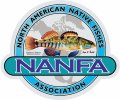Captive Care Notes: Sturgeons (Family Acipenseridae)
As big river fishes, sturgeons are ill-suited for life in all but large and specially constructed aquaria. (Species that are protected cannot be legally possessed without special permits.) Sand- or bare-bottomed tanks are recommended since gravel can injure a sturgeon's sensitive barbels and mouth. Also make sure the tank has as much open swimming area as possible, as aquarium-kept sturgeons tend to get stuck behind filter intake tubes, wedged under rocks and other aquarium fixtures, and even trapped within plants. A sturgeon attempting to extricate itself from such a situation may succumb to exhaustion or stress. The sturgeon's rostrum also can take a beating in the hard, angular surfaces of aquarium life, sometimes leading to fatal infections. If you can round off the corners in a sturgeon aquarium, by all means do.
Biologists who study sturgeons in captivity often keep them in expensive water-circulating aquaria designed to simulate strong river currents, increase dissolved oxygen, and maintain superior water quality. Researchers at the U.S. Army Corp of Engineer's Waterways Experiment Station in Vicksburg, Mississippi, feed hatchery reared juvenile Pallid Sturgeon commercial salmon pellets and report outstanding growth and health, However, wild-caught specimens refuse prepared foods and only begin to accept shrimp and chunks of frozen bloodworms after a couple of weeks in captivity.
Hatchery-raised juveniles of Shovelnose Sturgeon and White Sturgeon are occasionally sold in tropical fish stores. Juvenile sturgeons are irrepressibly cute; even normally detached researchers fall under the spell of their charm. "In the lab, juveniles demonstrate an uncanny similarity to puppies," wrote three sturgeon biologists, "swimming in summersaults, wagging their tails and watching with beady, reflective eyes at feeding times. Indeed, when fed a diet of floating pellets, these fish will learn to feed, while 'belly-up,' from the surface. This 'unfishlike' behaviour often allows an attachment between researcher and subject that is unknown with other fish species."
The sturgeon species most likely to survive for long periods in the average home aquarium is the Shovelnose Sturgeon. They can tolerate higher temperatures and will eat a variety of live and frozen foods, such as blackworms and frozen brine shrimp. Shovelnose Sturgeon can be trained to accept prepared diets, but care must be taken not to feed too much at once as they are slow eaters.
Keeping White Sturgeon in captivity means having the space to accommodate their growth; it is, don't forget, the largest fish in North America. One account in the aquarium literature reported 7.6 cm (3 in) White Sturgeon juveniles growing to 51 cm (20 in) in 18 months. This account also described the sturgeon's behavior in captivity, and steps taken to prevent its injury. The sturgeon were ceaselessly active and more rowdy than usual at night; keeping the tank dimly lit after hours seemed to calm them down. Because of their near-constant swimming, they were fed 5-6 times a day. The sturgeon also had the habit of sticking their heads out of the water, whereupon they bashed their rostra on the glass cover and cut it on the little lip that's around the inner perimeter of the top of the aquarium. The author raised the glass cover 12 inches from the top of the tank, and created a "bumper" around the top of the aquarium with silicone and tape. By the time these sturgeon reached 20 inches, they were eating a half-pound of earthworms, shrimp, and smelt per fish per week.
Obviously, the sturgeon's size, long life, and habitat requirements preclude them from spawning in the home aquarium. However, the artificial propagation of sturgeons in private and government fish hatcheries has been successful.
